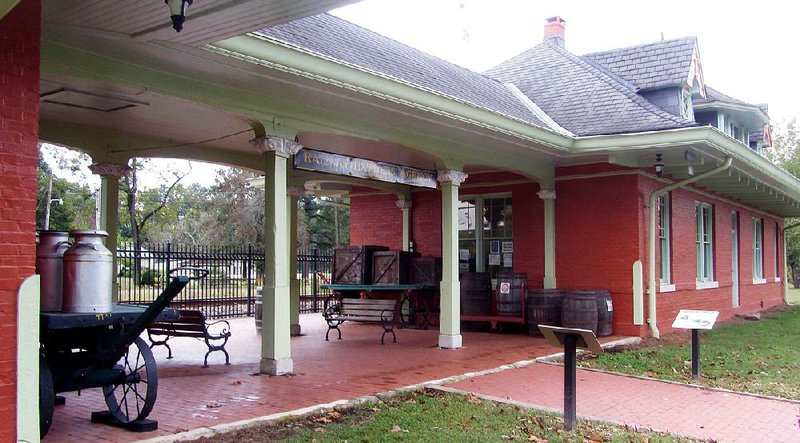MAMMOTH SPRING -- The occasional rumble of a passing freight train adds evocative sound effects to Arkansas' northernmost railroad station, which bustled a century and more ago with frequent passenger service to what was then a popular vacation spot.
Now a nostalgia-sparking museum, the Frisco Railroad depot is part of Mammoth Spring State Park. The park lies just south of the Missouri line, with its visitor center also serving as an Arkansas welcome facility for southbound travelers.
The railroad built the depot in 1885 as part of a new line between Memphis and Springfield, Mo. With the world's seventh-largest natural spring as the prime attraction, tourists began taking the trains here from as far away as St. Louis and Chicago. A plaque in the restored station conveys its importance locally at a time when automobiles, movies and radio were still on the horizon:
"Mammoth Spring Depot rapidly became the social hub of the community. Area residents were fascinated with the comings and goings of the massive steam engines and enjoyed the excitement of ringing brass bells and the woeful song of the steam whistle.
"The depot was every small town's source for world news, new products of every description and the latest issue of the Montgomery Ward or Sears & Roebuck catalog. This was where you came to greet friends or bid them farewell. This was your stepping off point to a world of adventure."
Jim Crow laws were enforced across the South at the time, a fact reflected in the depot's separate waiting rooms. It's no surprise the facility for white passengers is larger and better furnished than the one for blacks. A dozen life-size mannequins populate the station, adding to the sense of time travel.
The Frisco depot is one of 15 stops on the park's mostly level Spring Lake Trail, which circles the body of water in a loop running less than a mile. A brochure, available at the visitor center, gives details on each of the stops around the 10-acre body of water. The spring itself can't be seen, as a sign explains, because its outflow is concealed in a stone crevasse more than 80 feet below the lake's surface.
Spring Lake Trail crosses the dam built in 1888 to power a wheat mill. Rights to the dam were bought in 1925 by Arkansas-Missouri Power Co., which constructed a hydroelectric plant that supplied local power until 1972. The massive generator and other plant workings can be seen up close. The dam harnesses the spring's flow of nearly 10 million gallons an hour at a steady water temperature of 58 degrees.
The trail brochure highlights flora and fauna that can be seen along the way. There are sycamore trees, easily identified by their bark, which peels in thin brown scales to show the whitish inner layer. Red and white oak trees appear elsewhere, as do cattails and weeping willows.
Visitors who think they've spotted a beaver swimming across the lake are actually seeing a muskrat, which is smaller and has a rounded tail. Muskrats use aquatic plants to build cone-shaped houses that rise up to a yard above the water line. The lake's waterfowl include coots, mallards and wood ducks.
Before the arrival of the first European settlers early in the 19th century, the area around Mammoth Spring had been inhabited for many centuries by Osage and other American Indian nations. A wistful legend from that prehistory is posted in the park's visitor center:
"Long ago, a group of Indians camped in this area along the Warm Fork River. When a long and terrible drought occurred, the river nearly ran dry. The chief sent his son and other warriors to seek more water. During the search, the chief's son died.
"While burying him, a large stream of water shot from the grave site. The chief vowed the new spring would flow forever since his son had died searching for water and it had been found while burying him. So the story goes."
Mammoth Spring State Park is located about 160 miles north of Little Rock off U.S. 63. The park's visitor center is open 8 a.m.-5 p.m. daily. The railroad museum is open 8 a.m.-noon and 1-5 p.m. Wednesday-Saturday, 1-5 p.m. Sunday. Admission is free. Call (870) 625-7364 or visit ArkansasStateParks.com.
Weekend on 10/13/2016
